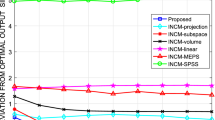Abstract
In this paper, a new robust adaptive beamforming technique based on a modification of the robust Capon beamforming approach is introduced. It is shown that this technique leads to an approximate eigenspace projection-based array steering vector estimation. The steering vector is estimated as an approximation for the orthogonal projection of the presumed steering vector of the desired signal onto the signal-plus-interference subspace. Also, it is demonstrated that the optimal diagonal loading factor corresponds to the minimum of the estimated beamformer output power. Furthermore, the formulation of the proposed method provides the possibility of estimating the direction-of-arrival of the desired signal. This estimation is then used to update the presumed steering vector. An important virtue of the proposed method is its better or comparable performance with less computational complexity than the recent existing methods.







Similar content being viewed by others
References
F. Chen, F. Shen, J. Song, Robust adaptive beamforming using low-complexity correlation coefficient calculation algorithms. IET Electron. Lett. 51(6), 443–445 (2015)
L. Du, J. Li, P. Stoica, Fully automatic computation of diagonal loading levels for robust adaptive beamforming. IEEE Trans. 46(1), 449–458 (2010)
A. Elnashar, S.M. Elnoubi, H.A. ElMikati, Further study on robust adaptive beamforming with optimum diagonal loading. IEEE Trans. 54(12), 3647–3658 (2006)
D.D. Feldman, L.J. Griffiths, A projection approach for robust adaptive beamforming. IEEE Trans. Signal Process. 42(4), 867–876 (1994)
J. Goldberg, H. Messer, Inherent limitations in the localization of a coherently scattered source. IEEE Trans. Signal Process. 46(12), 3441–3444 (1998)
Y. Gu, A. Leshem, Robust adaptive beamforming based on interference covariance matrix reconstruction and steering vector estimation. IEEE Trans. Signal Process. 60(7), 3881–3885 (2012)
Y. Gu, N.A. Goodman, S. Hong, Y. Li, Robust adaptive beamforming based on interference covariance matrix sparse reconstruction. Signal Process. 96, 375–381 (2014)
F. Huang, W. Sheng, X. Ma, Modified projection approach for robust adaptive array beamforming. Signal Process. 92(7), 1758–1763 (2012)
W. Jia, W. Jin, S. Zhou, M. Yao, Robust adaptive beamforming based on a new steering vector estimation algorithm. Signal Process. 93(9), 2539–2542 (2013)
O. Kukrer, S. Mohammadzadeh, Generalised loading algorithm for adaptive beamforming in ULAs. IET Electron. Lett. 50(13), 910–912 (2014)
C.C. Lee, J.H. Lee, Eigenspace-based adaptive array beamforming with robust capabilities. IEEE Trans. 45(12), 1711–1716 (1997)
J. Li, P. Stoica, Z. Wang, On robust Capon beamforming and diagonal loading. IEEE Trans. Signal Process. 51(7), 1702–1715 (2003)
J.P. Lie, W. Ser, C. See, S. Meng, Adaptive uncertainty based iterative robust Capon beamformer using steering vector mismatch estimation. IEEE Trans. Signal Process. 59(9), 4483–4488 (2011)
X. Mestre, M.A. Lagunas, Finite sample size effect on minimum variance beamformers: optimum diagonal loading factor for large arrays. IEEE Trans. Signal Process. 54(1), 69–82 (2006)
S. Nai, W. Ser, Z.L. Yu, H. Chen, Iterative robust minimum variance beamforming. IEEE Trans. Signal Process. 59(4), 1601–1611 (2011)
P. Stoica, R.L. Moses, Spectral analysis of signals. In: Parametric Methods for Line Spectra (Prentice Hall, New Jersey, 2005), pp. 159–163
H. Van Trees, Detection, Estimation, and Modulation Theory—Part IV Optimum Array Processing (Wiley, New York, 2002)
X. Yuan, L. Gan, Robust adaptive beamforming via a novel subspace method for interference covariance matrix reconstruction. Signal Process. 130, 233–242 (2017)
C. Zhou, Y. Gu, S. He, Z. Shi, A robust and efficient algorithm for coprime array adaptive beamforming. IEEE Trans. Signal Process. 67(2), 1099–1112 (2018)
C. Zhou, Z. Shi, Y. Gu, Coprime array adaptive beamforming with enhanced degrees-of-freedom capability. In: IEEE Conference on Radar, Seattle, WA, USA (2017) pp. 1357–1361
Author information
Authors and Affiliations
Corresponding author
Appendix
Appendix
1.1 Appendix A
The following inverse of a partitioned matrix [17] can be used to evaluate the inverse on the left-hand side of (10)
where \( \mathbf A \in C^{m\times m} \) , \( \mathbf B \in C^{n\times n} \) , \( \mathbf C \in C^{m\times n} \), \( \mathbf D \in C^{n\times m} \). We need to find the inverse \( (\mathbf A ^H_s\mathbf A _s)^{-1} \) as follows:
with the appropriate associations
Multiplying the left-hand side of (31) by \( \mathbf A _s \) and the right-hand side by \( \mathbf A _s^H \) and rearranging (31) will be expressed as (10).
1.2 Appendix B
The matrix \( (\mathbf I +\lambda \mathbf R ) \) can be written as follows:
where \( \mathbf R _{n\lambda }=(1+\lambda \sigma ^2_n)\mathbf I +\lambda \mathbf A _i\varvec{\varSigma }_i\mathbf A ^H_i \). Using the well-known matrix inversion lemma, the inverse becomes
Again by using the same lemma, the inverse of \( \mathbf R _{n\lambda } \) can be written as follows:
where \( \mathbf P \) is the second term within the square brackets and \( \lambda _d=1/\lambda \). By substituting (34) into (33) , multiplying both sides by \( \bar{\mathbf{a }} \) and simplifying gives
where \( \mu (\lambda )=(1+\lambda \sigma ^2_n)/(\lambda \sigma ^2_s) \) and \( \eta (\lambda )=\mathbf a _o^H(\mathbf I -\mathbf P )\bar{\mathbf{a }}/ (\mu (\lambda )+\mathbf a _o^H(\mathbf I -\mathbf P )\mathbf a _o) \). From (35), we obtain
Note that the noise power \( \sigma ^2_n \) can be estimated from the eigenvalue decomposition of the covariance matrix. Here, the minimum of the eigenvalues is taken as an estimate of the noise power.
Rights and permissions
About this article
Cite this article
Mohammadzadeh, S., Kukrer, O. Modified Robust Capon Beamforming with Approximate Orthogonal Projection onto the Signal-Plus-Interference Subspace. Circuits Syst Signal Process 37, 5351–5368 (2018). https://doi.org/10.1007/s00034-018-0818-4
Received:
Revised:
Accepted:
Published:
Issue Date:
DOI: https://doi.org/10.1007/s00034-018-0818-4




